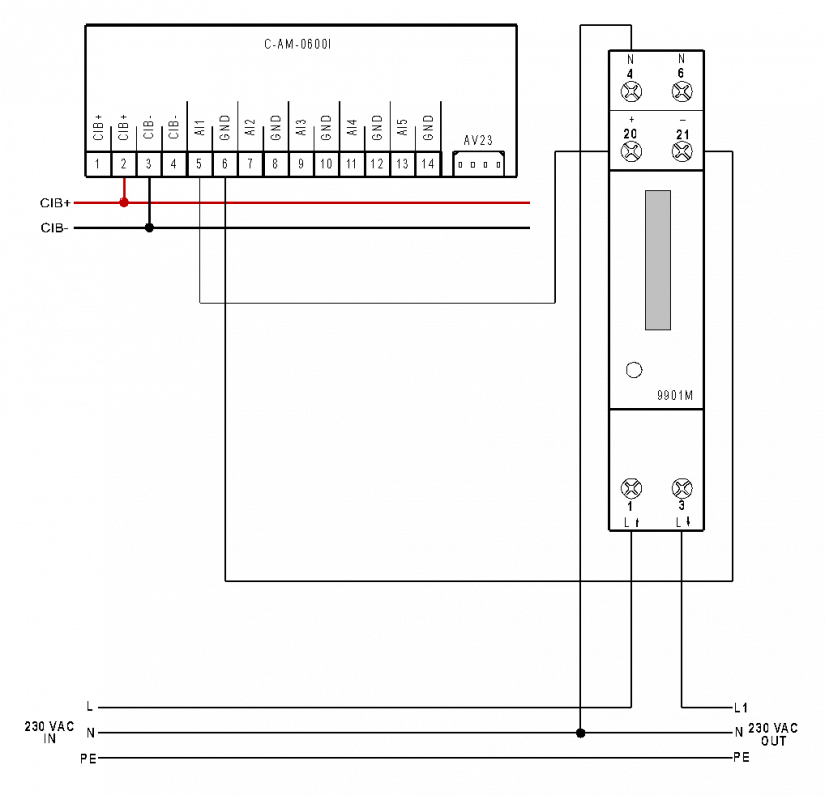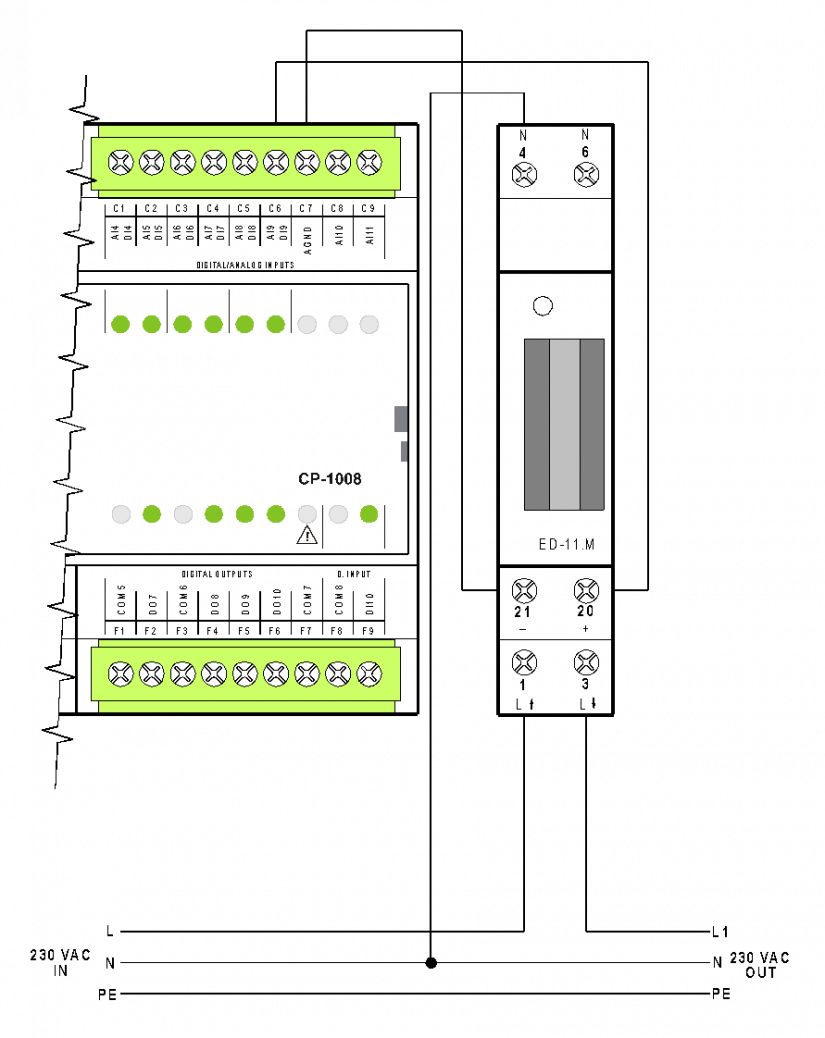Metering the consumed energy (e.g. by the monitoring of the heat pump consumption) can be done by electricity meters with the S0 output; we deliver the 9901M electricity meter, and the ED11.M meter can also be used for some applications. The primary function of the C-AM-0600I modules is to connect the S0 electricity meters with a pulse output, in accordance with IEC 62053 it is class A (for more information on the S0, see the end of this chapter). The electricity meters that comply with the class B can be connected e.g. directly to the CP-1008 inputs.
The SW function block enables you to get the total energy consumed and the calculated instantaneous power and current (assuming a constant 230 VAC voltage).

Fig. 1. An example of wiring the 9901M electricity meter to the C-AM-0600I module
Notes:
-
The grid voltage input is connected to terminal 1, the output (with measured consumption) to terminal 3. The outside wire N is connected to terminal 4 or 6 (the terminals are connected internally), or the N wire can be lead through the meter ("V" connection).
-
For detailed parameters of 9901M, see the following text and the table.
-
In order to connect the electricity meter S0 output, a standard cable can be used, min. 2x 0.5 mm, e.g. the SYKFY 2x2x0.5, with a maximum cable length 100 m.

Fig. 2. An example of connection the ED11.M electricity meter to the CP-1008 basic module
Notes:
-
The grid voltage input is connected to terminal 1, the output (with measured consumption) to terminal 3. The outside wire N is connected to terminal 4 or 6 (the terminals are connected internally), or the N wire can be lead through the meter ("V" connection).
-
For detailed parameters of ED11.M, see the following text and the table.
-
In order to connect the electricity meter S0 output, a standard cable can be used, min. 2x 0.5 mm, e.g. the SYKFY 2x2x0.5, with a maximum cable length 100 m.
The properties and parameters of the 9901M electricity meter
The 9901M electricity meter is an electronic meter for monitoring the power consumption in the area of small-scale customers; its size is similar to a circuit-breaker module.
It is a single-phase static single-tariff electricity meter for active energy in the accuracy class 1, which is designed for direct connection. It is designed for sub-metering of consumption up to 45A without official verification. The mechanical counter displays the measured values in the kWh units with 5 whole and one decimal digit (a total of 6 digits).
The 9901M electricity meter measures in the range from 25mA inrush current up to 45 A.
The electricity meter is equipped with an S0 interface in accordance with IEC 61393/DIN 43864. The circuit is galvanically isolated and transmits impulses with frequency that corresponds with the power consumed.
The design allows an easy installation on a DIN rail.
Basic parameters of the 9901M electricity meter
|
Connection |
direct two-wire |
|
|
Internal consumption |
maximum 0.4 W |
|
|
The range of the measured current |
25 mA ÷ 45 A |
|
|
Nominal voltage Un |
230 VAC ±30 % |
|
|
Pulse output: |
||
|
|
The number of pulses |
1,000 imp./1 kWh |
|
|
Nominal supply voltage |
12 ÷20 VDC |
|
Operating temperature range |
-20 ÷ 50 °C |
|
|
Maximum cross-section of the connected wire |
6 mm2 |
|
|
The terminal bolt head |
4.5mm combined groove |
|
|
The torque of screw terminals |
2 ÷ 5 Nm |
|
|
The module dimensions (width x height x depth) |
18 x 90 x 58 mm (1M) |
|
The properties and parameters of the ED11.M electricity meter
The ED11.M electricity meter is an electronic meter for monitoring the consumption of electric power supplied to retail customers; the size is similar to a circuit breaker.
It is a single-phase static single-tariff electricity meter for active energy in the accuracy class 1, in accordance with the ČSN EN 61036 standard, it is designed for direct connection. It is designed for sub-metering of consumption up to 25 A without a possibility of official verification. The mechanical counter displays the measured values in the kWh units with 5 whole and one decimal digit (a total of 6 digits).
The ED11.M electricity meter measures in the range from a 20 mA inrush current up to 25 A, with a sufficient margin in accordance with the standards.
The electricity meter is equipped with an S0 interface in accordance with IEC 61393/DIN 43864. The circuit is galvanically isolated by an optocoupler, to whose output a transistor with an open collector is connected; it emits pulses with a frequency that corresponds to the energy consumed.
The design allows an easy installation on a DIN rail.
Basic parameters of the ED11.M electricity meter
|
Connection |
direct two-wire |
|
|
Internal consumption |
maximum 0.5 VA |
|
|
The range of the measured current |
20 mA ÷ 25 A |
|
|
Nominal voltage Un |
230 VAC |
|
|
The operating voltage range |
0.85 Un ÷ 1.1 Un |
|
|
Pulse output: |
||
|
|
The number of pulses |
1600 imp./1 kWh |
|
|
Nominal supply voltage |
18 ÷27 VDC |
|
Operating temperature range |
-20 ÷ 55 °C |
|
|
Maximum cross-section of the connected wire - a string |
4 mm2 |
|
|
Maximum cross-section of the connected wire - a wire |
4 mm2 |
|
|
Minimum cross-section of the connected wire |
1 mm2 |
|
|
The terminal bolt head |
4.7 mm combined groove |
|
|
The torque of screw terminals |
0.5 Nm |
|
|
The module dimensions (width x height x depth) |
18 x 88 x 58 mm (1M) |
|
In accordance with the IEC 61393/DIN 43 864 standard, the electricity meter output signal provides the information about consumption; one pulse corresponds to a certain amount of active electrical energy measured by the meter. Most electricity meters generate from 500 to 10,000 pulses/1 kWh (this value is entered into the function block in the programming environment).
The output in electricity meters is usually designed with a semiconductor switching element (the passive output), the output is measured by the system input powered typically by 24VDC voltage; some outputs can be supplied with as little as 8 VDC, a maximum voltage is about 20 ÷ 30 VDC (a maximum current is usually no more than 30mA ).
N.B.: Some electricity meters meet the specifications for S0, class A (e.g. the 9901M) and they can be connected e.g. to the C-AM-0600I module; these meters can also be connected to standard binary 24 V inputs (e.g. the IB-1301 peripheral module), but some electricity meters have a limited range of voltage and current in the S0 output switched-on mode - such as the ED11.M electricity meter. These electricity meters can be connected directly to the binary inputs of the basic modules CP-1008 and CP-1006 (see the example above), but they cannot be connected to the inputs with the 24 V (IB-1301), or the S0 inputs in Class A (C-AM-0600I).
The S0 output terminals in the electricity meters are usually numbered 20 and 21.
 The polarity of the output must be observed, and some electricity meters have on the terminal 20 the negative pole, some have the positive pole (see e.g. the ED11.M meter).
The polarity of the output must be observed, and some electricity meters have on the terminal 20 the negative pole, some have the positive pole (see e.g. the ED11.M meter).
 English
English